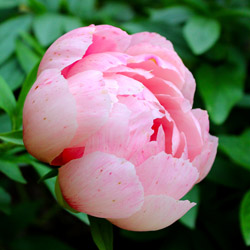Gardening is an immersive, sensory experience. You see the rich colors of the flowers, foliage, and produce you grow, and hear the bees buzzing, birds singing, and wind rustling whenever you work in the garden. You feel the grains of dirt beneath your fingers with planting and weeding, and feel all the textures of your plants as well as the heat of the sun and the wetness of the rain. You will even taste your harvest and herbs. Smell, however, is often overlooked or restricted to just a few classically fragrant blooms. There are many innovative options to add an aromatic atmosphere to your garden, however, to truly help you focus all your senses on the beauty of nature.
Scents of the Garden
When you’re working in your garden, you will easily enjoy the naturally fresh, cleaner air among your plants. You may smell the richness of the soil, a hint of compost, or subtle aromas from typical garden plants. More intense scents invite you to pause and breathe deeply, savoring the moment and refreshing your mind as well as your nose. The more you notice scents in your garden, the more you will be aware of subtle aromatic changes that may indicate a rotting plant, a fungal infection, overwatering, or other problems that need addressing. Sweeter scents will lead you to prolific blooms, ripe produce, and the peak of your harvest. Whichever scents are part of your garden, you need to take the time to appreciate each of them and the distinct outdoor perfume they create.
Adding Scents to Your Garden
There are many outstanding plants that can add even more enticing aromas to your garden. Many beautiful flowers have rich and pleasing scents, including…
- Angel’s trumpet – Soft and exotic with light, lemony overtones
- Butterfly bush – A lighter scent reminiscent of mild lilacs
- Dianthus – Intensely aromatic with a spicy hint of cloves
- Flowering tobacco – A sweeter scent especially potent at night
- Freesia – Fresh and sweet without being overpowering
- Gardenia – Strong and sultry with a velvety scent
- Heliotrope – Sweet with hints of vanilla and cherry
- Honeysuckle – Sweet and potent with a touch of honey
- Hyacinth – Lightly floral scent that gradually intensifies
- Jasmine – Rich and sweet, but not all varieties are equally potent
- Lilac – Intensely floral and a characteristic scent of spring
- Lily-of-the-valley – Sweet and fresh without an overpowering aroma
- Mock orange – Bold scent highly reminiscent of oranges
- Peony – Freshly floral with different intensities depending on variety
- Phlox – Sweet and intense, but can be overpowering in large amounts
- Plumeria – Beautifully tropical with hints of sweet peaches or citrus
- Rose – Classically floral with many variations from rich to sweet
- Sweet alyssum – Intensely sweet with notes of honey
- Sweet autumn clematis – Heady and sweet for summer and fall gardens
- Sweet pea – Lightly fragrant and classically floral
- Viburnum – Potent and spicy, though different cultivars have different scents
In addition to flowers, herbs can also add aromatic accents to the garden, though often with earthier or muskier tones than most flowers. The most scent-sational herbs include…
- Basil – Reminiscent of both pepper and mint with a touch of anise
- Lemon balm – A blended scent of citrus with a hint of mint
- Marjoram – Slightly woody and spicy but not generally overpowering
- Mint – Refreshing and cleansing, with many varieties available
- Pineapple sage – Startlingly reminiscent of fresh, ripe pineapple
- Rosemary – Earthy and savory, with hints of pine
- Spearmint – A light and sweet mint variety
- Thyme – Strong, hot, sometimes pungent scent
No matter which scented plants you choose to grow in your garden, you can either grow them as separate and distinct plants so each one can be savored individually, or you might group several compatible scents together to create a customized perfume. Starting with just a few aromas can help you better learn which scents work well together to enhance different aromas, and as you get more familiar with each scent, you’ll have a much better sense of which aromas are your favorites for blending into rich bouquets to savor.
Stop and Smell Your Garden
There are many ways to enjoy the scents in your garden, and you should always take time for a simple pause and a few deep breaths to take in the aromas you’ve carefully chosen. Strategic planting can also provide reminders to do just that when you position sweetly scented plants near pathways and entrances, climbing over an arbor, or filling a window box – places you’re more likely to catch a wafting aroma. Be sure to visit your garden and focus on the subtle changes in scents in different temperatures, after a rainstorm, or during different parts of the season, and you’ll better understand the gentle nuances your garden brings to your life with every meaningful inhalation.





